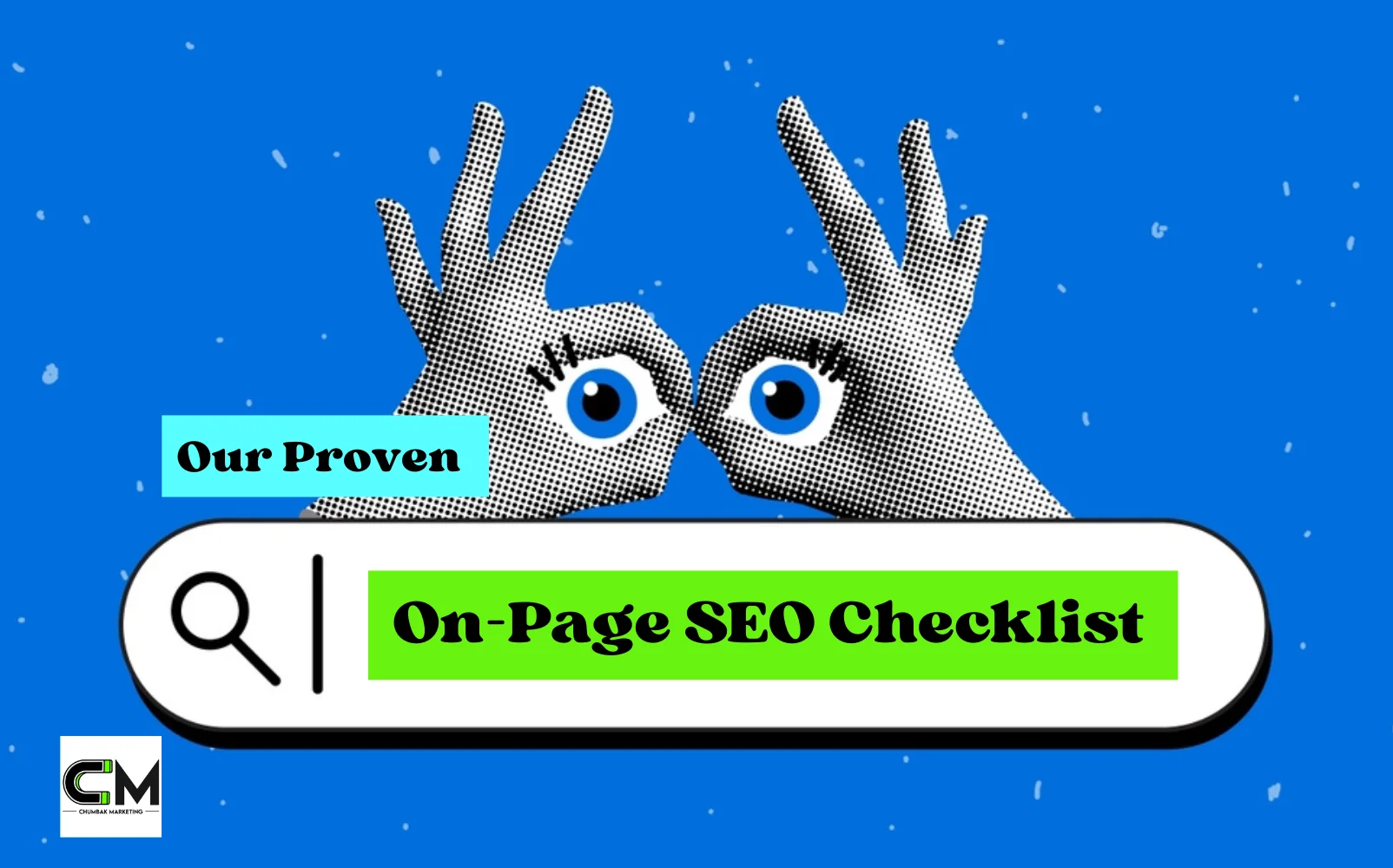44 On-Page SEO Checklist for Google SERP Rankings in 2025
Introduction
On-page SEO is not optional if you are really committed to increasing the exposure of your website. At Chumbak Marketing, we've refined our process through hundreds of real audits, experiments, and live client implementations to bring you a practical 44 checklist that works in 2025.
This guide is designed for businesses, content teams, and website managers looking for professional-level clarity without the fluff. From simple title tags to sophisticated technical inspections, here is your road map for better rankings.
Why On-Page SEO Still Matters in 2025?
Search engines still rely on on-page cues if one is to understand, rank, and offer relevant content. Although off-page factors like backlinks matter, your chances of ranking decline dramatically without strong on-page structure and optimization.
Google's latest updates-including Helpful Content, RankBrain, and SpamBrain-are built to surface content that provides genuine answers, shows expertise, and delivers value to users. That's why it's more important than ever to get on-page SEO right.
With search results constantly adapting based on user behavior, intent signals, and voice search, your pages need to be easy to understand for both humans and machines. The tactics shared below are grounded in what's working now-and what will keep working through 2025.
✅ Title & Meta Optimization
Keyword in Title Tag: Use your primary keyword naturally in the title.
Title Tag Starts with Keyword: Start strong. Search engines often weigh the first words more heavily.
Keyword in Description Tag: Helps improve click-through rate (CTR) even though not a direct ranking factor.
Why Does This Section Matters?
Your title and meta descriptions are your first handshake with users in the search results. A well-optimized title improves visibility and increases your chances of earning clicks. Agencies offering on-page SEO services consistently emphasize this area due to its strong impact on impressions and click-throughs.
✅ Header Structure
Keyword in H1 Tag: Keep your H1 unique per page, and match the user's intent.
Keyword in H2, H3 Tags: Reinforce relevance and improve scannability for users.
Expert Insight
Search engines read headings to understand the hierarchy and content flow. A well-organized header structure not only aids SEO but helps visitors find what they're looking for without confusion-essential for high retention.
✅ Content Optimization
TF-IDF: Include naturally related terms and variations. Tools like SurferSEO can help.
Content Length: Aim for thorough content. PagesBroken links harm both SEO and user experience with 1200+ words often perform better.
Table of Contents: Useful for long posts; helps both users and Google understand structure.
LSI Keywords in Content: Add context by including semantic variations.
LSI Keywords in Title/Description: Subtle variations boost contextual signals.
Page Covers Topic In-Depth: Don't leave the reader with questions-cover subtopics fully.
Keyword Prominence: Place the primary keyword early in the first 100 words.
Bullets and Numbered Lists: Increases readability and improves chances of featured snippets.
Real-World Application
When auditing websites as part of our on-page SEO audit services, we frequently find missing LSI terms, lack of content depth, and buried keywords. Fixing these issues alone has improved client traffic by over 40% in under 90 days.
✅ Internal & External Links
Outbound Link Quality: Link to credible sources with relevant authority.
Outbound Link Theme: Stay topically consistent. Avoid off-topic references.
Internal Links to the Page: Build internal authority with relevant incoming links.
Broken Links: Broken links harm both SEO and user experience. Run routine checks with any SEO Checker.
Tip from Our Agency
Linking isn't just about adding hyperlinks-it's about strategic placement. For agency-level SEO strategies in 2025, we create internal link maps that support a silo structure, improving crawlability and user navigation.
✅ Mobile & Usability Factors
Mobile-Friendly Update: Your site must be responsive. Test using Google's Mobile-Friendly tool.
Mobile Usability: Text should be readable without zooming. Avoid intrusive popups.
Hidden Content on Mobile: Ensure mobile users get the full content experience-not just desktop users.
Why Is This Non-Negotiable?
With mobile accounting for more than half of global search traffic, mobile usability is not optional. Google prioritizes mobile-first indexing, which means your mobile experience directly impacts rankings.
✅ Content Quality & Uniqueness
Grammar and Spelling: Errors reduce credibility. Use tools like Grammarly.
Syndicated Content: Avoid duplicating content from other sites. Use canonical tags if necessary.
Content Provides Value and Unique Insights: Add firsthand tips, case data, or insights-not just summaries.
Useful Content: Focus on solving the user's problem, not just matching keywords.
Content Hidden Behind Tabs: Ensure it loads in the DOM and is crawlable by search engines.
✅ Media & Enrichment
Multimedia (images, videos, infographics): Supports higher engagement and time on page.
Image Optimization: Use alt tags, compress file sizes, and use descriptive file names.
References and Sources: Link to original research or data sources where relevant.
Entity Match: Mention key entities related to the topic to improve semantic relevance.
✅ Technical SEO
HTML Errors/W3C Validation: Clean code helps search engines crawl your site more effectively.
Rel=Canonical: Avoid duplicate content problems by setting canonical URLs properly.
URL Length: Shorter is better. Aim for under 60 characters.
URL Path: Use a clean, flat structure (e.g., /seo/on-page-checklist/).
Keyword in URL: Reinforces relevance to users and search engines.
✅ Structural & Strategic Factors
Priority of Page in Sitemap: Set priority levels based on importance.
Page Category: Group pages under clear categories to improve topical authority.
Page's PageRank:Pages linked from high-authority internal pages tend to rank better.
Page Age: Older, well-maintained pages tend to perform better-don't always chase "fresh."
✅ Content Freshness & Updates
Content Recency: For time-sensitive topics, reflect the latest information.
Magnitude of Content Updates: Add or revise major portions-don't just change a sentence.
Historical Page Updates: Regularly updated pages send positive freshness signals.
✅ Trust & Transparency Signals
Reading Level: Aim for 8th grade readability. Tools like Hemingway can guide you.
Affiliate Links: Mark clearly and don't overwhelm content with monetized links.
User-Friendly Layout: Ensure clean design, visible headings, and smooth navigation.
Pro Tip: Use This Checklist for On-Page SEO Audits
This isn't just for new content. Use this same checklist to run an on-page SEO audit on existing pages. We regularly use it for our clients at Chumbak Marketing to uncover weak spots and ranking opportunities.
Need Professional On-Page SEO Services?
If you're unsure where to start or need a full website audit, our team at Chumbak Marketing offers expert-level on-page SEO services tailored for 2025's algorithmic landscape. We focus on scalable improvements that actually move the rankings.
Frequently Asked Questions (FAQs)
Describe on-page SEO?
On-page SEO is the technique of improving individual web pages to show higher in search results. It comprises structure, HTML source code, content, and usability enhancements.
Results from on-page SEO take what length of time?
Depending on the authority of your site, competition, and current structure, most improvements show in 4-6 weeks; but, it might take up to 3 months.
Does doing on-page SEO call for technical expertise?
While major fixes-like schema implementation or canonical tags-often need for expert expertise, basic optimizations can be accomplished without technical knowledge.
Off-page and on-page SEO differ in what ways?
On-page SEO is mostly concerned with improvements inside your website. Off-page SEO deals with outside elements such social signals, brand mentions, and backlinks.
Can I use this checklist for eCommerce or service websites?
Yes. This checklist works across content types-whether you're optimizing a blog, product page, or service landing page.
Final Word
Good rankings begin on a well-optimized page. This checklist provides a clear, tested road map whether your site is being improved or a new blog is being started.
Need help implementing these strategies? Contact Chumbak Marketing today for tailored SEO optimization agency support.




Leave a comments: